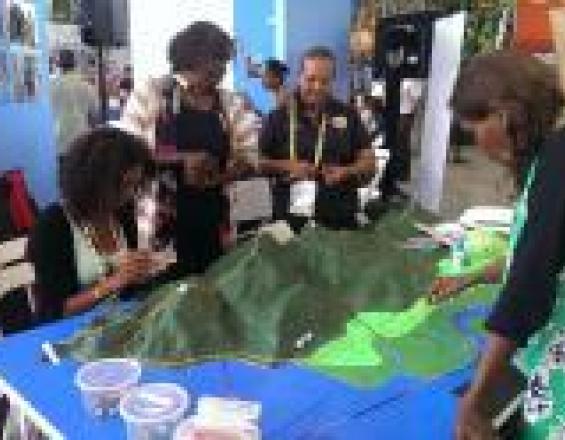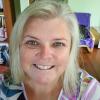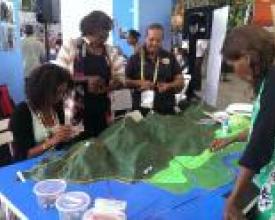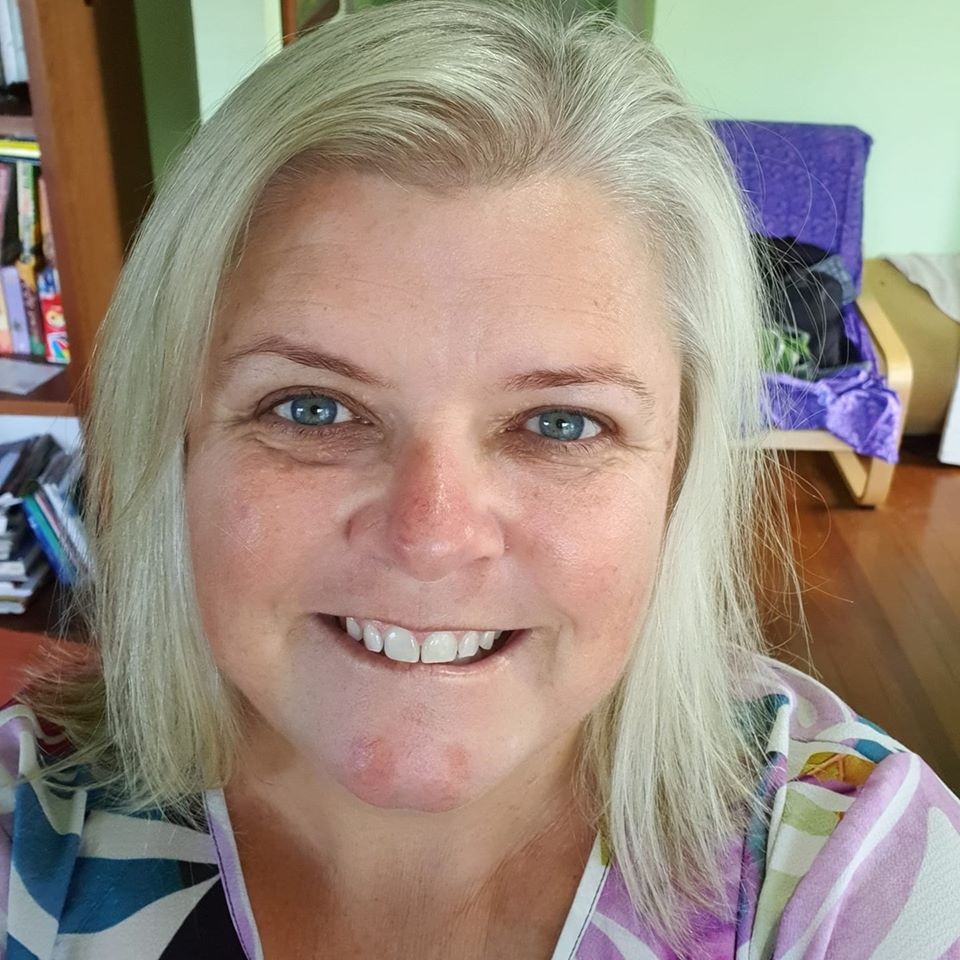Renforcer le pouvoir des Mandingalbay Yidinji grâce au P3DM

Les Mandingalbay Yidinji (MY) de la zone du patrimoine mondial des Tropiques humides, en Australie, ont utilisé la modélisation tridimensionnelle participative (P3DM) pour renforcer leur communauté en cartographiant et en partageant leurs connaissances culturelles et paysagères. Le projet a été facilité par l'autorité de gestion des Tropiques humides et a impliqué l'ensemble de la communauté MY. Les décisions concernant les éléments à montrer et ceux à exclure ont été entièrement prises par le peuple MY.
Contexte
Défis à relever
Perte d'informations culturelles dans les zones protégées Une grande partie des informations culturelles vitales dans les zones protégées est perdue lorsque les détenteurs des connaissances meurent, sont déconnectés et/ou lorsqu'ils ne peuvent pas accéder aux sites culturels clés. De nombreuses méthodes de cartographie des informations culturellement sensibles ne sont pas fiables et sont trop techniques. Le P3DM permet aux populations indigènes de jouer un rôle moteur dans le processus.
Emplacement
Traiter
Résumé du processus
Un P3DM est le résultat d'un processus bien facilité avec une véritable participation à la base. Chaque bloc de construction repose sur une base solide créée au cours des blocs de construction précédents. La capacité du facilitateur à maintenir les participants impliqués et à les faire travailler a été le ciment de la continuité et a permis aux participants de lui faire confiance. La construction du modèle "à l'échelle" a suscité des questions et de la curiosité, ce qui a généré un intérêt continu et une appropriation du produit "construit par la communauté". L'engagement des participants dans le projet s'est approfondi à chaque étape successive de l'implication et au fur et à mesure qu'ils "expérimentaient" la valeur du processus. Le P3DM ne se limite pas à la cartographie des connaissances, il a été utilisé dans le monde entier pour la planification des zones protégées, l'impact du changement climatique, la résolution des conflits, la cartographie des ressources, la gestion de la faune et de la flore, l'enregistrement du patrimoine immatériel, etc. L'autonomisation des Yidinji de Mandingalbay par le biais du P3DM leur insufflera une nouvelle confiance pour être les agents du changement dans leur propre environnement.
Blocs de construction
Identification et sélection des communautés
Facteurs favorables
Leçon apprise
Information de la communauté et sélection du site
Facteurs favorables
Leçon apprise
Préparation technique et SIG
Facteurs favorables
Leçon apprise
Création et accord sur la légende/clé du modèle
Facteurs favorables
Leçon apprise
Construction du modèle
Facteurs favorables
Leçon apprise
Représentation des connaissances sur le modèle
Facteurs favorables
Leçon apprise
Impacts
Le projet P3DM entrepris en octobre 2014 a déjà produit des impacts et des changements. Un membre de la communauté MY a déclaré : "...ce projet m'a permis de renouer avec mon pays, mon paysage, je ne m'y attendais pas...". Ce projet a permis à la communauté de se rassembler pour se concentrer sur quelque chose de positif et de participer à un processus dont les membres de la communauté MY pouvaient contrôler les résultats, ce qui est rare pour les populations autochtones australiennes. Le processus P3DM a également permis de renouer le contact avec des jeunes qui s'étaient déconnectés de la culture et du paysage - ils se sont intéressés à ce que les membres plus âgés de la communauté avaient à dire et ont commencé à se rendre compte de l'étendue des connaissances culturelles qui subsistent chez MES aînés.
Le projet P3DM a déjà encouragé les habitants de MY à utiliser le modèle pour planifier des activités de développement économique sur leurs terres traditionnelles afin de créer des moyens de subsistance plus durables. Un autre impact est l'inspiration que ce projet a suscitée chez d'autres peuples autochtones pour qu'ils apprennent à connaître et à utiliser eux-mêmes le P3DM. Dans l'idéal, les membres de MY seront les premiers à faciliter les futures activités P3DM avec d'autres communautés autochtones. Cela permettra d'élargir, de renforcer et d'approfondir l'impact.
Bénéficiaires
Peuple aborigène Mandingalbay Yidinji et Autorité de gestion des tropiques humides.
Objectifs de développement durable
Histoire
En novembre 2014, six représentants de Mandingalbay Yidinji ont participé au 6e Congrès mondial des parcs à Sydney, en Australie. Au cours de la phase de construction, la communauté a développé une "ébauche" supplémentaire de 2m x 1m qui a été transportée par la route jusqu'à Sydney. Les représentants de MY ont passé 3 à 4 jours à faire une démonstration en direct au Congrès, décrivant lentement leurs connaissances à l'aide de peinture, d'épingles et de brins de laine, sur la feuille blanche. Outre les informations sur le patrimoine culturel, ils ont également cartographié des frontières telles que la zone du patrimoine mondial des Tropiques humides et la zone protégée indigène de Mandingalbay Yidinji. Cette démonstration en direct, qui s'est déroulée dans le pavillon des communautés WIN et Pacific, a attiré l'attention et suscité un réel intérêt de la part de délégués du monde entier. Le travail effectué par MON peuple a créé une excitation autour du pavillon et a attiré les gens à poser des questions sur le processus et sur MON pays traditionnel. Plus de 250 délégués ont laissé leur carte de visite à la démonstration pour obtenir plus d'informations sur le P3DM ! La démonstration faisait partie d'une série de congrès sur le P3DM coordonnés par le Centre technique de coopération agricole et rurale (CTA). Le CTA a également coordonné la participation de praticiens P3DM du Kenya, du Tchad, du Suriname, de Samoa, d'Éthiopie, de Trinidad et de PNG. La rencontre et le partage d'expériences avec d'autres praticiens autochtones du P3DM, ainsi que la conversation avec des délégués du monde entier, ont aidé les membres de MY à comprendre l'importance de leur propre expérience dans un contexte mondial. L'expérience de la WPC a renforcé la confiance des délégués de MY et leur conviction que la P3DM est une technique très utile. Lors d'une session du congrès sur les risques et les avantages de la cartographie des connaissances traditionnelles, les membres de MY ont présenté le modèle achevé au congrès et ont parlé de leurs expériences au cours du processus et en tant que peuple autochtone de la forêt tropicale. Le champion du Congrès, M. Luvuyo Mandela, a assisté à la présentation et, dans un discours émouvant, a déclaré : "En tant qu'autochtones, nous devons apprendre un langage qui nous aide à communiquer ce dont nous avons besoin et qui nous sommes d'une manière qui soit digeste pour le reste de la communauté. Cette initiative est incroyable".



